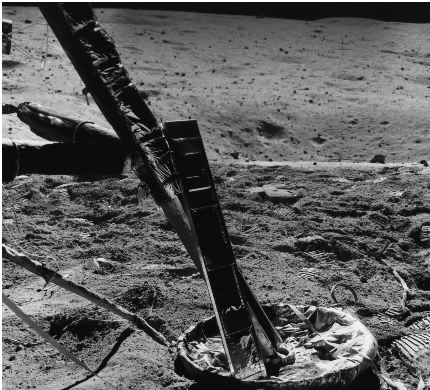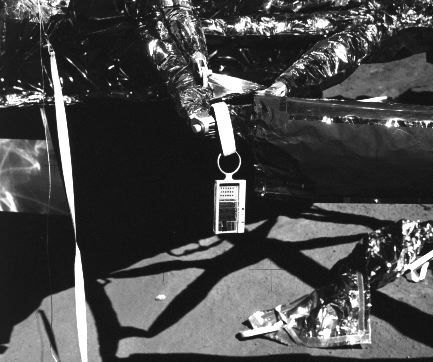Experiment Operations During Apollo EVAs
Experiment: Cosmic Ray Detector (A-16)
a.k.a. Cosmic Ray Experiment, Cosmic Ray Detector Experiment
Acronym: CRD (CRE,CRDE)
Experiment: Lunar Surface Cosmic Ray Experiment (A-17)
Acronym: LSCRE

The CRD as relocated on the -Y footpad of the LM, looking down-sun,
where it was place on EVA 1 (AS-16-107-17442). Also visible in the background
is the tilted cask which contained the fuel element which powered the RTG.

The portion of the LSCRE which was located in the sun hanging from
the landing strut of the Apollo 17 LM (AS-17-140-21382).
PI/Engineer: R. L. Fleischer, General Electric R&D Lab, Schenectady,
NY
Other Contacts:
Buford Price, U. C. Berkeley Robert M. Walker, Washington Univ. E.
Zinner, St. Louis
Apollo Flight Nos.: (11) 16, 17
Apollo Exp't No. S 152 (S 151 on A-11)
Discipline: radiation, solar; radiation, cosmic; solar wind
Weight: 163 g (LSCRE)
Dimensions: 22.5 x 6.3 x 1.1 cm (LSCRE); 5 x 18.4 x 30 cm (CRD,
folded for return)
Manufacturer: General Electric
Description/Purpose:
The CRD on A-16 consisted of a 4 panel array of passive particle track
detectors to observe cosmic ray and solar wind nuclei and thermal neutrons,
and also included metal foils to trap light solar wind gasses. As the particles
passed through the materials, they left tracks which could be observed
after preferential chemical attack, allowing the particles to be identified
and counted.
A new set of smaller detectors was carried to the surface on the
A-17 mission. Two sets were exposed, one set facing the Sun and one set
in the shade facing away.
On A-11, the cosmic ray detection experiment was entirely passive
and was limited to post-mission analysis of the flight helmets.
Unloading from the LM:
On A-16, it was mounted to the LM before launch and first exposed to
space just after TLI when the LM was withdrawn from the adapter. It was
left in place during EVA 1, but moved to a shadowed foot pad during the
2nd EVA because of high temperatures.
On A-17, a two-part experiment was performed, one in the sun and
one in the shade. Neither was exposed until the first EVA on the surface,
when they were hung on the descent stage of the LM. To avoid contamination,
the LSCRE was transported to the Moon in a plastic bag inside the LM cabin
in storage area A5.
Transporting by foot or MET: NA
Loading/unloading tools/exp'ts on LRV: NA
Site selection: NA
Deploying experiment:
On A-16, it was to be deployed by pulling a lanyard on the unit. It
broke. The crew had never seen the experiment deployed and could not tell
whether the lanyard broke at the end of its normal travel or at an intermediate
point. In fact, it was only partially deployed due to incorrectly installed
screws which interfered with the travel of the plates. This degraded portions
of the experiment.
On A-17, the LSCRE was deployed by first pulling the slide cover off
while in the shade of the LM and hanging the cover on a hook attached to
the side of the LM. The cover remained in the shade, with the detectors
pointed toward space, for 45.5 h. After deployment of the cover, the box
portion of the LSCRE was carried into sunlight and hung on the strut of
the LM using the Velcro strap attached to the end ring. Deployment was
nominal and was completed early in EVA 1. It was intended to have the sun
half be perpendicular to the rays of the sun. This was accomplished, based
on photos with no visible shade on the detector. The experiment was terminated
at the beginning of EVA 3.
Check-out of experiment:
On A-16, by the beginning of EVA-2, the temperature labels indicated
that the experiment was reaching its upper limit. The experiment was removed
from the LM and was placed on the -Y foot pad so that it faced away from
the Sun. The crew felt that the experiment may have reached this temperature
before landing due to the extra 3 revolutions before descent.
Operation of experiment:
The panels were aligned to a new position (to allow identifica-tion
of tracks by co-alignment in the new position) by pulling a lanyard.
Repairs to experiment:
At the end of the 1st EVA on A-16, the experiment was moved for thermal
control. Although the clean equipment should not have overheated, a deposit
of as much as 10% cover of dust would have produced excessive heating.
Temperature labels, designed to sense the approach to the permitted upper
limit, were located on the outboard face of the frame.. At the end of EVA
1, all of these labels had been affected, showing the temperature had exceeded
318 K; therefore, the contingency procedure was followed. It is not known
if the "dust" covering was from lunar dust from landing or a residue from
engine exhaust emplaced during transposition and docking.
Recovery/take-down of experiment:
On A-16, the experiment was terminated at the end of the 3rd EVA. The
panels were hung up inside the frame. After pulling so hard that the nylon
strap broke, it was necessary to use a pair of pliers to get sufficient
grip on the panels to free them for stowage. They were bagged for return
with the help of the LMP. On A-17, the array was pulled out of its frame
at the beginning of EVA 3, after 45.5 hours of exposure, and folded into
a compact 5 x 18.4 x 30 cm package for return to Earth. First, the sun
half was taken down, then the LMP walked into the shade and mated it with
the shade half. Thus, the shade half was never exposed to the sun. The
exposure time was cut from the original plan (through the end of EVA 3)
because Houston expected a small solar flare. The LMP was instructed to
place the LSCRE in a Beta cloth bag near the LM for retrieval at the end
of the EVA
Stowing experiment for return:
On A-16 the unit was placed into a plastic bag for return to Earth.
The A-17 LSCRE was stored inside a bag in interim stowage assembly F6 in
stowage area A3 for LM ascent.
Loading/unloading samples on LRV: NA
Loading of exp't/samples into the LM: No comment by crew.
Stowing of package once in the LM: No comment by crew.
Sampling operations - soil, rocks: NA
Trenching: NA
Raking: NA
Drilling: NA
Coring: NA
Navigating/recognizing landmarks: NA
Were there any hazards in the experiment?
i.e. hazardous materials (explosive, radioactive, toxic), sharp
objects, high voltages, massive, bulky, tripping hazards, temperatures?
No, but the array was hot to the touch, even through the gloves, when
recovered.
Was lighting a problem?
For A-16, only in a thermal sense. The array was to be kept below 328
K. For A-17, there were two portions to the experiment; one to be kept
in the shade and one exposed in the sunlight. There was no problem seeing
in the shade, however.
Were the results visible to the crew? Temperature labels were
visible on the outside.
Would you recommend any design changes?
A mistake in the final assembly caused the panels to be only partially
deployed. The experiment for A-17 was redesigned.
Were any special tools required?
Not nominally, although a pair of pliers was used on A-16 during recovery.
Was the orientation of the experiment (i.e. horizontal/vertical)
important? Difficult?
On A-17, one half of the experiment was in the shade and the other
half was exposed in the sunlight, relatively perpendicular to the solar
incidence.
Was the experiment successful? Partially.
Were there related experiments on other flights?
Analysis of the filter glass of Surveyor III (brought back by A-12).
Sounding rockets have been used to launch detectors during solar flares.
Also, the window of the A-12 spacecraft was analyzed for cosmic ray tracks.
One helmet on A-8 and 3 worn on A-12 were used as heavy-particle dosimeters.
A control helmet was also exposed to cosmic rays at a balloon altitude
of 41 km. The LNPE on A-17 measured thermal neutron fluence. The experiments
were supported by sun monitoring stations during the experimental period.
In particular, Vela and ATS-1 were mentioned.
Where was it stored during flight?
For A-16, on the LM descent stage. For A-17, inside the LM in storage
area A5 (aft, left side, near floor.)
Were there any problems photographing the experiment? No.
What pre-launch and cruise req'ts were there?
power, thermal, late access, early recovery? The temperature
was controlled below 328 K during trans-lunar coast (and supposedly while
on the surface) by covering with a perforated thermal control material.
What was different between training and actual EVA?
The experiment used in training was not functional, and the flight
unit could not be cycled. The crew commented after return that they should
operate a functional replica of every experiment during training.
What problems were due to the suit rather than the experiment?
None.
Any experiences inside the LM of interest from the experiment/operations
viewpoint? No.
References:
A-16 &17 Preliminary Science Reports
A-16 &17 Mission Reports
Apollo Scientific Experiments Data Handbook, JSC-09166, NASA TM X-58131,
August, 1974, In JSC History Office.
Apollo Program Summary Report, section 3.2.24 Cosmic Ray Detector Experiment,
JCS-09423, April, 1975.
Apollo Program Summary Report, section 3.3.8 Cosmic Ray Detector (Helmets),
JCS-09423, April, 1975.
Apollo 17 Final Lunar Surface Procedures, Vol. 1: Nominal Plans, MSC,
11/6/72
Apollo 16 Technical Crew Debriefing, 5 May 1972, in JSC History Office.
Personal communication with John Young, 1 April 1993.
Apollo Stowage List - Apollo 17, MSC, 12 December 1972.